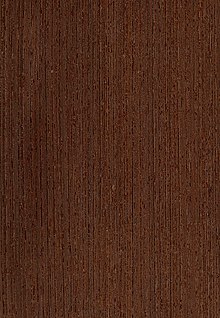Wenge
| Wenge | ||||||||||||
|---|---|---|---|---|---|---|---|---|---|---|---|---|

Wenge tree in bloom |
||||||||||||
| Systematics | ||||||||||||
|
||||||||||||
| Scientific name | ||||||||||||
| Millettia laurentii | ||||||||||||
| De Wild. |
The Wenge ( Millettia laurentii ) is a flowering plant in the subfamily of Schmetterlingsblütler (Faboideae) within the family of the Leguminosae (Fabaceae). In the home countries the common names Palissandre du Congo , Awong and Mundambi are used.
description
Millettia laurentii grows as a medium-sized tree that can reach heights of up to 20 meters and trunk diameters of 60 to 100 centimeters (but mostly less). The mostly crooked trunk is mostly free of knots up to a height of 15 meters. The bark is smooth and gray with visible lenticels ; if injured, a red exudate appears .
The alternately arranged, stalked leaves are imparipinnate with 9–17 leaflets . The petiole is 4–7 cm long, the rachis 10–18 cm. The short-stalked, bald leaflets are entire and pointed. They are ovate to elliptical or obovate and 6–15 cm long and 4–8 cm wide. The veins are pinnate and raised on the underside. Stipules are missing.
The flowers are in terminal, 20–40 cm long and paniculate inflorescences. The hermaphrodite butterfly flowers are zygomorphic , short-stalked and five-fold with a double flower envelope . There are two cover sheets . The five sepals are briefly hairy brown velvety and half cup-shaped fused with five tips. The five petals are whitish to purple. There are nine fused stamens and one free one. The Upper constant ovary is hairy, with a long pen .
The two- to four-seeded fruit is a flat and elongated legume , it is 15–28 cm long and 3–5 cm wide, with stiff walls, it is glabrous and finely striped. The rounded, smooth and purple-brown seeds are flattened and 18-25 mm in size. The young fruits are greenish with brown hairs.
distribution
Wenge is native to the tropical rainforests of Cameroon , the Republic of the Congo , the DR Congo , Equatorial Guinea and Gabon .
Endangerment and Status
The species is considered endangered (EN A1cd), the main causes are habitat destruction and, above all, excessive logging.
use
The wood has a narrow, gray-white sapwood , sharply separated from the light to dark brown core, which darkens strongly and takes on a coffee-brown to black color. The color can fade again through prolonged exposure to the sun. The kiln density is about 0.75 to 0.79 g / cm³, the bulk density is about 0.75 to 0.95 g / cm³. Moderately dwindling. Planed surfaces have a matt sheen. It is hard, heavy, elastic and weatherproof and is used in furniture and interior design, for doors, stairs and as parquet , also for woodturning , inlay and carving as well as for musical instruments (e.g. as a fingerboard for guitars or as a body of electric basses ). It is easy to work with, but tends to splinter if the grain is irregular.
health
Splinters of wenge that have penetrated the skin can cause inflammation in humans, the wood dust can cause skin irritation and stomach cramps .
Web links
- Millettia laurentii at PROTA.
- Millettia laurentii at Useful Tropical Plants.
- Millettia laurentii . In: S. Dressler, M. Schmidt, G. Zizka (Eds.): African plants - A Photo Guide. Senckenberg, Frankfurt / Main 2014.
Individual evidence
- ↑ Entry in Tropicos . (Brief description in French).
- ↑ Data sheet at International Legume Database Information Service = ILDIS - LegumeWeb - World Database of Legumes , Version 10.38 from July 20, 2010.
- ^ African Regional Workshop (Conservation & Sustainable Management of Trees, Zimbabwe) 1998. Millettia laurentii. In: IUCN 2006. 2006 IUCN Red List of Threatened Species.
- ^ Gesamtverband Deutscher Holzhandel eV: Wenge ( Memento from August 10, 2007 in the Internet Archive )

